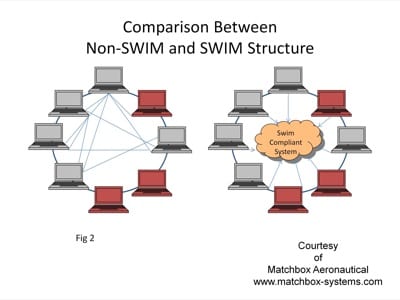By JEFFREY BOCCACCIO.
Over time I am sure that every pilot has appreciated the vast improvements in our communication abilities within the general aviation sector. Almost all of it is due to technological advancements that have been deployed, allowing for a huge increase in safety by providing increased details, improved efficiency and better precision from information shared throughout the National Airspace System (NAS).
Compound that with the FAA’s Next Generation Air Transportation System (NextGen), which will also provide aircraft with a newer and even more improved Service Oriented Architecture (SOA). This will improve the interoperability of a host of services inside and outside the NAS, including more flexibility, an ability to respond quickly, and being more efficient to any changes within the system. All this will be provided to aviators by way of a program called System Wide Information Management (SWIM). SWIM has the power to reduce the information congestion inside each pilot’s head by allowing him to fine-tune what and when he needs information.
So what is SOA and why have we not talked about or used these services before?
In reality we have. The only difference is that it has been an antiquated system that is not very efficient. You have to compare all of the aviation services available as you would any ordinary service provider from the Internet.

Figure 1 shows a typical type of architecture that we are currently using. No rocket science here — you ask and you will receive. We use these Requests (Reks) and Acknowledgements (Acks) all day long in data communication and system management, which is where everything is going these days. The only catch here is that in our current system it isn’t that simple to implement.
There is a huge information resource that many GA pilots don’t even know exists. The services that we are aware of already improve safety, increase situational awareness, keep us ahead of the airplane and, at the end of the day, provide pilots with a far more enjoyable experience. This relates to both recreational flying or flying for work. With SWIM, everyone will have the opportunity to know all the information that is available, where it is located and how to access it. This will improve situation awareness far beyond our current level.
Take, for instance, a few common services that pilots use in any typical flight experience, such as ATIS, AWOS, FSS, TFRs, NOTAMs, weather, including Sigmets and Convection Sigmets, flight following, ATC instructions, traffic, IFR filing, and more. All of these services are requested and acted upon, but all in their own unique way.
The reason for this is that all of it has been added or modified over time. That’s not a bad thing — it is just the natural progression that takes place when services are added or subtracted over time. As things are created and come alive they are added, and as they lose effectiveness they are used less and die.
Due to the continuing growth of the aviation community, the time has come to start cleaning this up and implement a new system than can be modified on the fly while still maintaining its structure and efficiency throughout the NAS. A standardized interface is needed allowing all services to “speak a common language.”

Figure 2 drives this home with more detail. On the left side is our current system, which is more a point-to-point type of information system. Each service has it own point or “connection interface” and it gets routed throughout the system that way.
I love it when people in the know say things to me like “don’t worry, you’re in the system.” What system? This mess? You really have to give all those ATC and support people credit for successfully using these legacy systems.
However, where we are going is what you see on the right side of Figure 2. It’s basically a cloud-based system with just one connection to the Cloud. Almost all of it can come to you as text messages and not necessarily voice. This one feature alone will allow pilots to be able to check each instruction without having to make that ugly call back to ATC, “Say again?”
Since there is so much information available like flight management, air space status and weather, the need to know every single part of it can overwhelm a pilot. There is quite a bit of information a pilot may never really need for the particular type of flying being executed. With SWIM all of these services can be customized to what information you want and when you want it. You don’t have to accept everything, you only set it up to what you want.
Why is this such a big deal? Why, all of a sudden is this worth talking about? The answer is really simple. It is our friend, technology, and how it has such a huge influence on every part of our lives, including NextGen. With these new system designs we can adapt to all aviation changes as they occur, now and in the future.
